教学法术语
- 格式:doc
- 大小:87.50 KB
- 文档页数:15
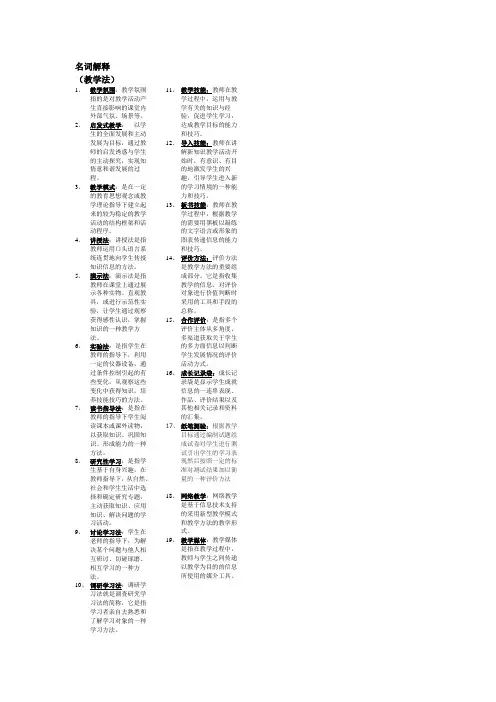
名词解释(教学法)1、教学氛围:教学氛围指的是对教学活动产生直接影响的课堂内外部气氛、场景等。
2、启发式教学:以学生的全面发展和主动发展为目标,通过教师的启发诱惑与学生的主动探究,实现知情意和谐发展的过程。
3、教学模式:是在一定的教育思想观念或教学理论指导下建立起来的较为稳定的教学活动的结构框架和活动程序。
4、讲授法:讲授法是指教师运用口头语言系统连贯地向学生传授知识信息的方法。
5、演示法:演示法是指教师在课堂上通过展示各种实物、直观教具,或进行示范性实验,让学生通过观察获得感性认识,掌握知识的一种教学方法。
6、实验法:是指学生在教师的指导下,利用一定的仪器设备,通过条件控制引起的有些变化,从观察这些变化中获得知识,培养技能技巧的方法。
7、读书指导法:是指在教师的指导下学生阅读课本或课外读物,以获取知识、巩固知识、形成能力的一种方法。
8、研究性学习:是指学生基于自身兴趣,在教师指导下,从自然、社会和学生生活中选择和确定研究专题,主动获取知识、应用知识、解决问题的学习活动。
9、讨论学习法:学生在老师的指导下,为解决某个问题与他人相互研讨、切磋琢磨、相互学习的一种方法。
10、调研学习法:调研学习法就是调查研究学习法的简称,它是指学习者亲自去熟悉和了解学习对象的一种学习方法。
11、教学技能:教师在教学过程中,运用与教学有关的知识与经验,促进学生学习,达成教学目标的能力和技巧。
12、导入技能:教师在讲解新知识教学活动开始时,有意识、有目的地激发学生的兴趣,引导学生进入新的学习情境的一种能力和技巧。
13、板书技能:教师在教学过程中,根据教学的需要用黑板以凝练的文字语言或形象的图表传递信息的能力和技巧。
14、评价方法:评价方法是教学方法的重要组成部分。
它是指收集教学的信息、对评价对象进行价值判断时采用的工具和手段的总称。
15、合作评价:是指多个评价主体从多角度、多渠道获取关于学生的多方面信息以判断学生发展情况的评价活动方式。
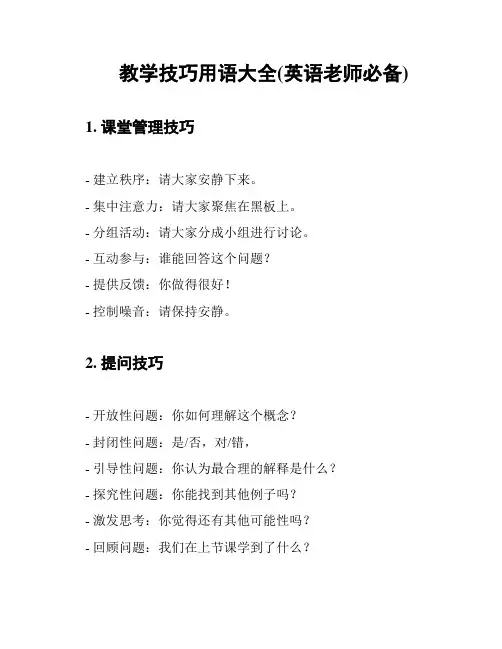
教学技巧用语大全(英语老师必备) 1. 课堂管理技巧- 建立秩序:请大家安静下来。
- 集中注意力:请大家聚焦在黑板上。
- 分组活动:请大家分成小组进行讨论。
- 互动参与:谁能回答这个问题?- 提供反馈:你做得很好!- 控制噪音:请保持安静。
2. 提问技巧- 开放性问题:你如何理解这个概念?- 封闭性问题:是/否,对/错,- 引导性问题:你认为最合理的解释是什么?- 探究性问题:你能找到其他例子吗?- 激发思考:你觉得还有其他可能性吗?- 回顾问题:我们在上节课学到了什么?3. 组织课堂活动- 活动介绍:今天我们将进行一个有趣的角色扮演活动。
- 清晰的指导:首先,你们需要分组,然后……- 时间控制:你们有5分钟完成这个任务。
- 小组展示:请每个组派一名代表来展示你们的成果。
- 知识点总结:现在让我们回顾一下我们学到了什么。
4. 纠正错误- 温和纠正:这个词的发音是...- 引导学生自我纠正:请再试一次,你发现自己犯了什么错误吗?- 同伴间互相纠正:请你同桌告诉他正确的答案。
- 理解错误来源:你是如何得出这个答案的?5. 备课技巧- 根据课程大纲进行规划:这节课我们要讲什么内容?- 设定研究目标:学生最终应该达到什么水平?- 准备教材与资源:我需要准备哪些教材和资源?- 创意教学方法:如何让学生更加投入?- 针对不同学生需求:如何调整教学策略?6. 评估学生研究- 笔试:请在纸上写出答案。
- 口试:请用英语回答下面的问题。
- 作业:下节课请交上一篇作文。
- 项目展示:请准备一个关于......的项目。
- 自评与同伴评价:你的朋友对你的答案有什么建议?以上是一些英语老师在教学过程中常用的技巧用语。
通过这些技巧,能够帮助教师更有效地管理课堂、引导学生思考和提高学生学习效果。
希望对您有所帮助!。
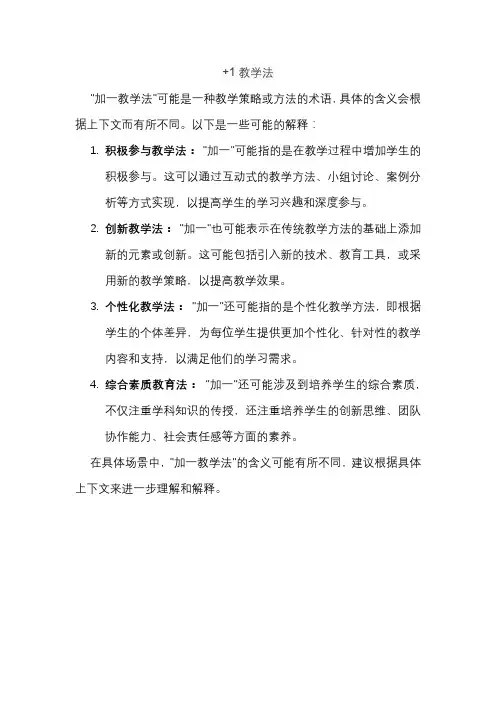
+1教学法
"加一教学法"可能是一种教学策略或方法的术语,具体的含义会根据上下文而有所不同。
以下是一些可能的解释:
1.积极参与教学法:"加一"可能指的是在教学过程中增加学生的
积极参与。
这可以通过互动式的教学方法、小组讨论、案例分
析等方式实现,以提高学生的学习兴趣和深度参与。
2.创新教学法:"加一"也可能表示在传统教学方法的基础上添加
新的元素或创新。
这可能包括引入新的技术、教育工具,或采
用新的教学策略,以提高教学效果。
3.个性化教学法:"加一"还可能指的是个性化教学方法,即根据
学生的个体差异,为每位学生提供更加个性化、针对性的教学
内容和支持,以满足他们的学习需求。
4.综合素质教育法:"加一"还可能涉及到培养学生的综合素质,
不仅注重学科知识的传授,还注重培养学生的创新思维、团队
协作能力、社会责任感等方面的素养。
在具体场景中,"加一教学法"的含义可能有所不同,建议根据具体上下文来进一步理解和解释。
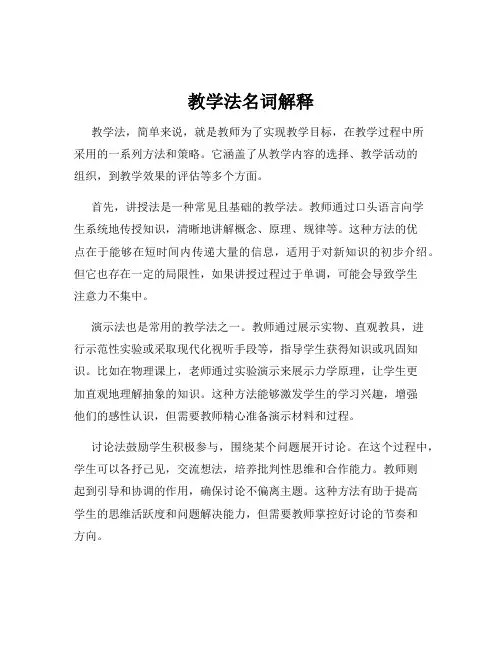
教学法名词解释教学法,简单来说,就是教师为了实现教学目标,在教学过程中所采用的一系列方法和策略。
它涵盖了从教学内容的选择、教学活动的组织,到教学效果的评估等多个方面。
首先,讲授法是一种常见且基础的教学法。
教师通过口头语言向学生系统地传授知识,清晰地讲解概念、原理、规律等。
这种方法的优点在于能够在短时间内传递大量的信息,适用于对新知识的初步介绍。
但它也存在一定的局限性,如果讲授过程过于单调,可能会导致学生注意力不集中。
演示法也是常用的教学法之一。
教师通过展示实物、直观教具,进行示范性实验或采取现代化视听手段等,指导学生获得知识或巩固知识。
比如在物理课上,老师通过实验演示来展示力学原理,让学生更加直观地理解抽象的知识。
这种方法能够激发学生的学习兴趣,增强他们的感性认识,但需要教师精心准备演示材料和过程。
讨论法鼓励学生积极参与,围绕某个问题展开讨论。
在这个过程中,学生可以各抒己见,交流想法,培养批判性思维和合作能力。
教师则起到引导和协调的作用,确保讨论不偏离主题。
这种方法有助于提高学生的思维活跃度和问题解决能力,但需要教师掌控好讨论的节奏和方向。
案例教学法以实际案例为基础,引导学生分析和解决问题。
通过真实的情境,让学生将理论知识应用到实际中,培养他们的实践能力和决策能力。
比如在法律课程中,通过分析具体的案例来加深对法律条文的理解和运用。
问题解决教学法以问题为导向,让学生在解决问题的过程中学习。
教师提出问题,激发学生的好奇心和求知欲,促使他们主动探索和思考。
这种方法能够培养学生的自主学习能力和创新思维。
情境教学法创设具有一定情绪色彩的、以形象为主体的生动具体的场景,以引起学生一定的态度体验,从而帮助学生理解教材,并使学生的心理机能得到发展。
例如在语文教学中,通过创设与课文内容相关的情境,让学生更好地感受作品的情感和意境。
还有探究式教学法,强调学生自主探究和发现知识。
教师引导学生提出问题、做出假设、收集证据、得出结论。
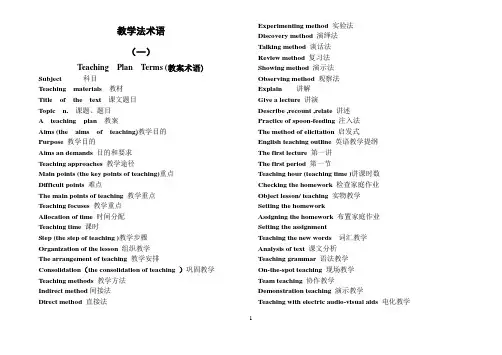
教学法术语(一)Teaching Plan Terms (教案术语) Subject 科目Teaching materials教材Title of the text课文题目Topic n. 课题、题目A teaching plan教案Aims (the aims of teaching)教学目的Purpose教学目的Aims an demands 目的和要求Teaching approaches教学途径Main points (the key points of teaching)重点Difficult points 难点The main points of teaching 教学重点Teaching focuses教学重点Allocation of time时间分配Teaching time课时Step (the step of teaching )教学步骤Organization of the lesson组织教学The arrangement of teaching 教学安排Consolidation(the consolidation of teaching )巩固教学Teaching methods 教学方法Indirect method间接法Direct method 直接法Experimenting method实验法Discovery method演绎法Talking method谈话法Review method 复习法Showing method 演示法Observing method观察法Explain 讲解Give a lecture讲演Describe ,recount ,relate 讲述Practice of spoon-feeding注入法The method of elicitation 启发式English teaching outline英语教学提纲The first lecture第一讲The first period第一节Teaching hour (teaching time )讲课时数Checking the homework 检查家庭作业Object lesson/ teaching实物教学Setting the homeworkAssigning the homework 布置家庭作业Setting the assignmentTeaching the new words 词汇教学Analysis of text课文分析Teaching grammar语法教学On-the-spot teaching 现场教学Team teaching协作教学Demonstration teaching演示教学Teaching with electric audio-visual aids电化教学1Teaching by demonstration示范教学The law of teaching 教学规律The rules of teaching (teaching principles)教学规则The end of education /the aims of education 教学目的Learn (master) ten mew words and be able to use them in actual situations 掌握并能实际应用十个生词。
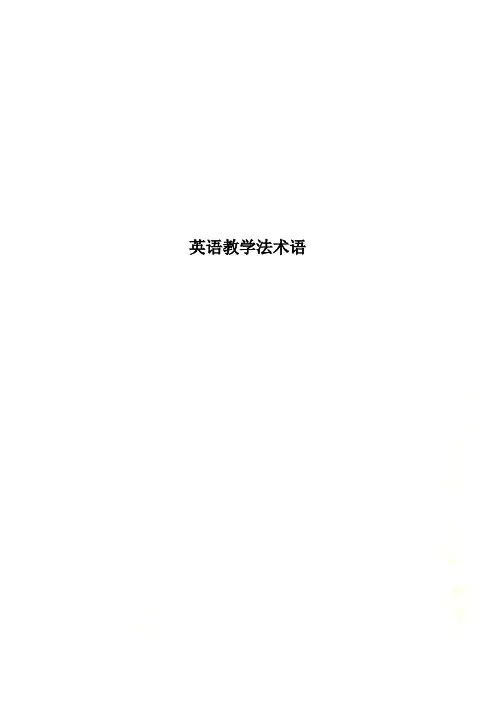
英语教学法术语The Terms of English Language Teaching Methodology英语教学法术语Aachievement test 成绩测试acquisition 习得,语言习得acquisition 语言习得顺序active mastery 积极掌握active vocabulary 积极词汇,主动词汇affective filtering 情感筛选aim,objective 目的,目标analysis of errors 错误分析analytic approach 分析教学法,分析法analytical reading 分析性阅读application to practice 运用于实践applied linguistics 应用语言学approach 教学路子aptitude test 能力倾向测验Army method 陆军法associative learning 联想性学习auditory discrimination 辨音能力auditory feedback 听觉反馈auditory memory 听觉记忆auditory perception 听觉audio-lingual method 听说法audio-visual method 视听法aural-oral approach 听说教学法,听说法aural-oral method 听说法Bbasic knowledge 基本知识basic principle 基本原则basic theory 基本理论basic training 基本训练basic vocabulary 基本词汇behaviourism 行为主义bilingual 双语的bilingual education 双语教育blank filling 填空Cchain drill 链式操练,连锁操练choral repetition 齐声照读,齐声仿读class management 课常管理classroom interaction 课常应对cloze 完形填空coach 辅导cognitive approach 认知法common core 语言的共同核心,语言共核communicative drill 交际性操练communicative exercise 交际练习communicative langunge teaching 交际派语言教学法,交际教学法community language learning 集体语言学习法comparative method 比较法communicative approach 交际法comprehensible input 不难理解的输入comprehensive method 综合法computer-managed instruction 计算机管理教学concord and coordination 默契与配合console 控制台consonant cluster 辅音连缀context 上下文controlled composition 控制性作文course density 课堂密度course design 课程设计cramming method 灌输式cue word 提示词curriculum 课程,教学大纲curriculum development 课程编制,课程设计cultrual objective,aim 教养目的cclical approach 循环教学法,循环法Ddeductive learning 演绎性学习deductive method 演绎法delayed auditory feedback 延缓听觉反馈demonstration 演示demonstration lesson 示范教学describe a picture in writing 看图说话describe a picture orally 描写语言学diagram 图解diagnostic test 诊断性测验dicto-comp 听写作文direct application 直接应用direct comprehension 直接理解direct learning 直接学习direct method 直接教学法Eeducational objective, aim 教育目的EFL 英语作为外语EGP 通用英语ELT 英语教学English as a Foreign Language 英语作为外语English as an International Language 英语作为国际语言English environment 英语环境English for Academic Purposes 学术英语English for general prupose 普通英语English for General Purposes 通用英语English for specific purposes 专用英语ESOL English for Speakers of Other Languages 供非英语民族使用的英语English medium school 英语授课学校English teaching;teaching English 英语教学WSD(English as a Second Dialect)英语作为第二方言WSL(English as a Second Language)英语作为第二语言ESL Programme(English as a Second Language Programme)英语(第二语言)教程ESP(English for Special Purposes)专用英语EST(English for Science and Technology)科技英语evaluation 评语,评价examination 考试examination question 考题experimental method 实验法extensive reading 泛读external speech 外语言语extra-curiculum activity 课外活动extra-curriculum club,group 课外小组Ffacial expression 面部表情feedbace 反馈film projector 电影放映机filmstrip 电影胶片final stage 高级阶段first language 第一语言,母语formative evaluation 自由作文free practice 自由练习frequency of word 词的频率al approach 功能法al syllabus 功能派教学大纲word 功能词Ggeneral linguistics 普通语言学gestalt style 格式塔式(学习),整体式(学习)gesture 手势getting students ready for class 组织教学global learning 整体式学习,囫囵吞枣式学习global question 综合性问题gradation 级进法,分级递升法graded direct method 循序直接法grading 级进法,分级递升法;评分grammar lesson 语法课grammar method 语法法grammar translation method 语法翻译法grammatical analysis 语法分析group reading 集体朗读group training 集体练习guided composition 引导性作文Hheuristic method of teaching 启发式教学法heurstics 启发法;探索法humanistic approach 人本主义教学法Iidealism 唯心主义imitatiom 模仿immersion programme 沉浸式教学imparting knowledge 传授知识incomplete plosive 不完全爆破independent composition 独立作文individualized instruction 个别教学individual training 个别练习inductive learning 归纳性学习inductive method 归纳法inflection,inflexion 词形变化information,processing 信息处理initial beginning stage 初级阶段inner speech 内语言语in-service training 在职培训instructional objective 语言教学目标integrative teaching 综合教学integrated approach 综合教学法,综合法intelligent memory 理解性记忆language training 强化教学intensive training 精读intermediate stage 中级阶段interpretation 头口翻译International Phonetic Alphabet 国际音标Jjuncture 连读,音渡junior high school 初级中学junior school 初级学校junior sceondary school 初级中等学校junior-senior high school 初高中junior technical college(or school) 初级职业学院(或学校)junior year 大学三年级Kkey words 基本词,关键字kinesics 身势语,身势学kinesthetic memory 动觉记忆knowledge 知识knowledge structure 知识结构Llanguage acquisition 语言习得language acquisition device 语言习得机制language arts 语言技能language competence,or knowledge 语言知识language learning capability 语言学习能力language laboratory;lab 语言实验室language leaning capacity 语言学习能力language pedagogy 语言教育language performance 语言行为language program design 语言课程设计language test 语言测试learning by deduction 演绎性学习learning by induction 归纳性学习learning process 学习过程learning style 学习方式lesson conducting 教课lesson plan 课时计划,教案lesson preparation 备课lesson type 课型linguistics 语言学linguistic competence 语言能力linguistic method 口语领先教学法living language 活的语言long-term memory 长期记忆look-and-say method 看图说话法Mmeaningful drill 有意义的操练neabubgful exercise 有意义的练习meaningful learning 理解性学习means of teaching 教学手段mechanical drill 机械操练mechanical exercise 机械练习mechanical memory 机械记忆mechanical translation 机器翻译medium of instruction 教学媒介语,教学语言memory 记忆,记忆力memory span 记忆幅度memorizing 用记记住method 方法methodology of teaching 教学法methodology of teaching English 英语教学法microteaching 微型教学mim-mem method 模仿—记忆法minimal pair 最小对立体(一种辨音练习)model 模型modeling 示范教学modern equipment 现代化设备modern language 现代语言monitor hypothesis 语言监控说mother tongue 母语motivation 引起动机Nnative language 本族语natural appoach 自然教学法,自然法natural method 自然法needs analysis 需要分析new lesson 新课nine-pile grading 九堆法notional approach 意念法notional-al syllabus 意念-功能派教学大纲notional syllabus 意念大纲、意念派教学大纲Oobservation lesson 观摩教学objective 教学目标optimum age hypothesis 学习最佳年龄说operating principle 操作原则oral approach 口语教学法,口语法oral exercise 口语练习oral method 口授法oral reading 朗读order of acquisition 语言习得顺序organization of teaching materials 教材组织organs of speech 发音器官outside reading 课外阅读overlearing 过量学习Ppaired-associate learning 配对联想学习法pair work 双人作业,双人练习passive vocabulary 消极词汇pattern drill 句型操练pattern practice 句型练习pdeagogical grammar 教学语法pedagogy 教育法peer teaching 同学互教penmanship handwriting 书法perception 知觉performance objective 语言实践目标personality 个性philosophy 哲学phoneme 音素phonetics 语音法phonetic method 按字母音值拼读法phonology 音位学picture 图画phasement test 分班测验plateau of learning 学习高原practical objective 实用目的practice effect 练习效应practice of teaching 教学实践presentation of new materials 提出新材料pre-teaching 预教primary of speech 口语领先principle of communication 交际性原则principle of teaching 教学原则problem solving 习题解答production stage 活用阶段,产出阶段productive exercise 活用练习productive mastery 活用掌握productive vocabulary 活用词汇proficiency 熟练program desing 课程设计psycho-linguistics 心理语言学psychological method 心理法Qqualified teacher 合格教师question band 试题库questionnaire 调查问卷questions 提问Rrapid reading 快速阅读,快读rate of reading 阅读速度readability 易读性read by turns 轮读reading 阅读reading lesson 阅读课reading method 阅读法reading speed 阅读速度reading vocabulary 阅读词汇,阅读词汇量receptive language knowledge 接受性语言知识receptive vocabulary 领会词汇reformed method 改良法regression 回看,重读reinforcement 巩固reinforcement lesson 巩固课repetition drill 复述操练repetition-stage 仿照阶段response 反应retelling 复述retention 记忆teview;tevision 复习review(revise)and check up 复习检查review(revision)lesson 复习课rewriting 改写rhythm 节奏role-play 扮演角色rote learning 强记学习法,死记硬背Sscanning 查阅,扫瞄school practice 教学实习scientific way of thinking 科学的思想方法second language 第二语言segment 音段,切分成分semantics 语义学seminar 课堂讨论sentence completion 完成句子short-term memory 短期记忆sight vocabulary 一见即懂的词汇silent reading 默读silent way 沉默法,静授法simplification 简写simplified reader 简写读本simulation 模拟,模拟性课堂活动simultaneous interpretation 同声翻译situational method 情景法situational language teaching 情景派语言教学法,情景教学法situational method 情景教学法situational syllabus 情景派教学大纲situation reinforcement 情景强化法skimming 略读,济览slide 幻灯片slide projector 幻灯片socialized speech 社会化言语socio-linguistics 社会语言学soft ware 软件speech disorder 言语缺陷speech pathology 言语病理学speech perception 言语知觉speech reading 唇读法speed reading 快速阅读,快读speelling 正字法spiral approach 螺旋式教学法,螺旋法spoken lauguang 口语stage of teaching 教学阶段stick drawing;mathch drawing 简笔画stimulus and response 刺激与反应stress accent 重音,重读structuralism 结构主义(语言学)structural method 结构法student-centered 学生中心student-centered learning 学生为主学习法student teacher 实习教师student teaching 教育实习submersion programme 沉浸式教程substitution 替换substitution table 替换表subvocal reading 默读suggestopaedia 暗示教学法syllabus 教学大纲syllabus design 教学大纲设计syllabus for middle school English 中学英语教学大纲synthetic approach 综合性教学法,综合法synthetical reading 综合性阅读Ttarget language 目的语,译文语言teacher’s book 教师用书teacher’s manual 教师手册teaching experience 教学经验teaching objective,aim 教学目的teaching procedure 教学过程teaching tools;property 教具teaching words in isolation 孤立教单词theory of teaching 教学理论TEFL 英语(外语)教学TESL 英语(第二语言)教学TESOL 对非英语民族教英语time allotment 时间分配total physical response method 整体动作反应法transformation drill 转换操练translation method 翻译法transformational generative grammar 转化生成语法Uunconscious 潜意识underclassman 低年级学生undergraduate 大学本科生undergraduate course 大学本科课程undergraduate school 大学本科学院undergraduate special 大学特殊课程unified studied 统一课程university high school 大学附属中学university of the air 广播电视大学updating courses/training 现代化课程/训练upgrading courses/training 进修课程/训练upperclassman 高年级学生use and usage 使用和用法utterance 语段Vverbal association 词语联想verbal learning 语言学习,单词学习video 电视,影象videotape 录象磁带visual perception 视觉visual aid 直观手段visit a class 听课visual memory 视觉记忆vocabulary control 词汇控制Wword association 词际联想word list 词表word study 词的研究word frequency 词汇重复率written language 书面语。
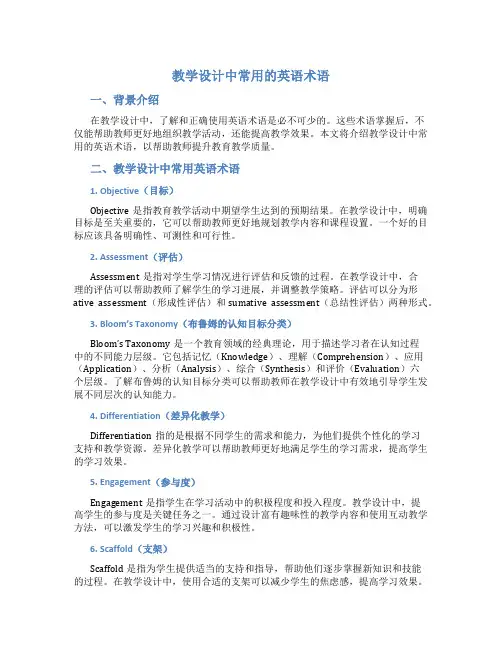
教学设计中常用的英语术语一、背景介绍在教学设计中,了解和正确使用英语术语是必不可少的。
这些术语掌握后,不仅能帮助教师更好地组织教学活动,还能提高教学效果。
本文将介绍教学设计中常用的英语术语,以帮助教师提升教育教学质量。
二、教学设计中常用英语术语1. Objective(目标)Objective是指教育教学活动中期望学生达到的预期结果。
在教学设计中,明确目标是至关重要的,它可以帮助教师更好地规划教学内容和课程设置。
一个好的目标应该具备明确性、可测性和可行性。
2. Assessment(评估)Assessment是指对学生学习情况进行评估和反馈的过程。
在教学设计中,合理的评估可以帮助教师了解学生的学习进展,并调整教学策略。
评估可以分为形ative assessment(形成性评估)和sumative assessment(总结性评估)两种形式。
3. Bloom’s Taxonomy(布鲁姆的认知目标分类)Bloom’s Taxonomy是一个教育领域的经典理论,用于描述学习者在认知过程中的不同能力层级。
它包括记忆(Knowledge)、理解(Comprehension)、应用(Application)、分析(Analysis)、综合(Synthesis)和评价(Evaluation)六个层级。
了解布鲁姆的认知目标分类可以帮助教师在教学设计中有效地引导学生发展不同层次的认知能力。
4. Differentiation(差异化教学)Differentiation指的是根据不同学生的需求和能力,为他们提供个性化的学习支持和教学资源。
差异化教学可以帮助教师更好地满足学生的学习需求,提高学生的学习效果。
5. Engagement(参与度)Engagement是指学生在学习活动中的积极程度和投入程度。
教学设计中,提高学生的参与度是关键任务之一。
通过设计富有趣味性的教学内容和使用互动教学方法,可以激发学生的学习兴趣和积极性。
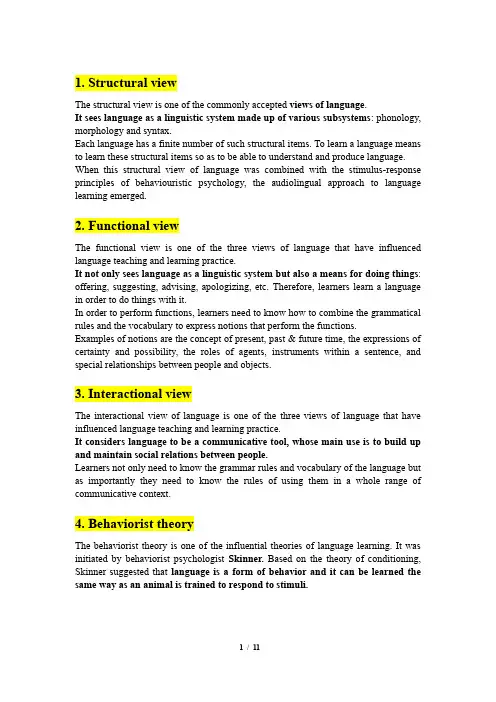
1. Structural viewThe structural view is one of the commonly accepted views of language.It sees language as a linguistic system made up of various subsystems: phonology, morphology and syntax.Each language has a finite number of such structural items. To learn a language means to learn these structural items so as to be able to understand and produce language. When this structural view of language was combined with the stimulus-response principles of behaviouristic psychology, the audiolingual approach to language learning emerged.2. Functional viewThe functional view is one of the three views of language that have influenced language teaching and learning practice.It not only sees language as a linguistic system but also a means for doing things: offering, suggesting, advising, apologizing, etc. Therefore, learners learn a language in order to do things with it.In order to perform functions, learners need to know how to combine the grammatical rules and the vocabulary to express notions that perform the functions.Examples of notions are the concept of present, past & future time, the expressions of certainty and possibility, the roles of agents, instruments within a sentence, and special relationships between people and objects.3. Interactional viewThe interactional view of language is one of the three views of language that have influenced language teaching and learning practice.It considers language to be a communicative tool, whose main use is to build up and maintain social relations between people.Learners not only need to know the grammar rules and vocabulary of the language but as importantly they need to know the rules of using them in a whole range of communicative context.4. Behaviorist theoryThe behaviorist theory is one of the influential theories of language learning. It was initiated by behaviorist psychologist Skinner.Based on the theory of conditioning, Skinner suggested that language is a form of behavior and it can be learned the same way as an animal is trained to respond to stimuli.5. Cognitive TheoryCognitive Theory is represented by Chomsky. In this theory, students are asked to think rather than simply repeat. According to Chomsky, language is not a form of behavior, it is an intricate rule-based system and a large part of language acquisition is the learning of this system. There are a finite number of grammatical rules in the system and with a knowledge of these an infinite number of sentences can be produced. A language learner acquires language competence which enables him to produce language.6. Constructivist theoryJohn Dewey provided a foundation for constuctivism. The constructivist theory believes that learning is a process in which the learner constructs meaning based on his/her own experiences and what he/she already knows. It is believed that education is used to develop the mind. Teachers need to design environment and interact with learners to foster inventive, creative, critical learners.7. Socio-constructivist TheorySocio-constructivist Theory represented by Vygotsky emphasizes interaction and engagement with the target language in a social context based on the concept of 'Zone of Proximal Development' (ZPD)最近发展区and scaffolding教学支架.In other words, learning is best achieved through the interaction between the teacher and the learner and between learners(通过使用目标语在社交情境中进行师生之间和生生之间的互动可以达到最佳的学习效果).With the teacher's scaffolding through questions and explanations, or with a more capable peer's support, the learner can move to a higher level of understanding and extend his/her skills and knowledge to the fullest potential.8. Communicative competenceThe general aim of language teaching is to develop students’ communicative competence. Communicative competence is the aspect of our competence that includes both the knowledge about the language and the knowledge about how to use the language appropriately in communicative situations.It entails knowing not only the language code or the form of language, but also what to say to whom and how to say it appropriately in any given situation.Hedge discusses five main components of communicative competence. Namely, linguistic competence, pragmatic competence, discourse competence, strategic competence, and fluency.Linguistic competence: It is concerned with knowledge of the language itself, its form and meaning. Linguistic competence is an integral part of communicative competence and it is wrong to think that communicative language teaching does not aim for high standard of linguistic correctness.Pragmatic competence: It is concerned with the appropriate use of the language in social context. That is to say, the choice of vocabulary and the structure depends on the setting, the relative status of the speakers and their relationships.Discourse competence: It refers to one’s ability to create a coherent written text or conversation and the ability to understand them. It also includes one’s ability to initiate, develop, interrupt or confirm in a conversation.Strategic competence: It is similar to communication strategies. It refers to strategies one employs when there is communication breakdown due to lack of resources. One can compensate for this by searching for other means of expression, such as using a similar phrase, using gestures or using a longer explanation. In this way, they can keep the conversation going and possibly get input from the other end.Fluency:It means one’s ability to link units of speech together with facilities and without strain or inappropriate slowness or undue hesitation. Teaching learners lexical phrases or chunks of language, also termed as prefabricated language can help learners produce language more fluently.9. PPPPPP (Presentation, Practice and Production) model of teaching is a traditional teaching model. (是什么)In language teaching, a typical PPP lesson would include the following steps:(怎么做)Presentation- the teacher introduces a new language item in a context.Practice -students are guided to do some controlled practice, such as drilling, repetition, dialogue reading, etc.Production- students produce the language in a more meaningful way, such as a role play, a drama, an interview, etc.PPP offers a simplified approach to language learning, which could save time when teaching new language items.(优点)10. Task-based Language TeachingIt refers to an approach based on t he use of tasks as the core unit of instruction in language.It’s a further development of communicative language teaching and it shares the same beliefs, as language should be learned as close as possible to how it is used in real life. It stressed the importance to combine form-focused teaching with communication-focused teaching.11. Linguistic CompetenceLinguistic Competence is one of the main components of Communicative Competence, and it is concerned with knowledge of the language itself, its form and meaning. More specifically, it involves spelling, pronunciation, vocabulary, word formation, grammatical structure, sentence structure, and semantics.12. Pragmatic competencePragmatic competence is one of the important components of communicative competence. It is concerned with the appropriate use of the language in social context. That is to say, the choice of vocabulary and structure in language use depends on the setting(背景), the relative status of the speakers(说话者之间的相对地位), and their relationships(他们之间的关系亲疏).13. Discourse competenceDiscourse competence is one of the components of communicative competence. It refers to one's ability to create coherent written text or conversation and the ability to understand them (理解和输出完整连贯的书面语篇或口头话语的能力).In other words, it is one's ability to express or to understand a topic logically and coherently by effectively employing or comprehending the cohesive markers used (通过高效地使用衔接词有逻辑性地、条理清楚地理解和表达一个话题的能力)According to Hedge, it also includes one's ability to initiate, develop, enter, interrupt, check, or confirm in a conversation. (语篇能力也包括开启一段对话、展开对话、中途插话、与对方核对观点、确认信息等交流能力)14. Strategic competenceStrategies one employs when there is communication breakdown such as paraphrasing or finding a synonym when unable to retrieve a word.15. Fluencythe ability to link units of speech together with facility and without strain or inappropriate slowness or undue hesitation.16. TaskA task can hold different meanings for different people. In language teaching, a task is a piece of classroom work which involves learners in comprehending, manipulating, producing or interacting in the target language while their attention is principally focused on meaning rather than form.Generally speaking, a task has four main components: a purpose, a context, a process and a product.17. Information gap activitiesInformation gap activities are one type of communicative activities.In an information gap activity, the participants have different information and they need to obtain information from each other in order to finish a task.Therefore, the participants have a real communicative purpose and they will try to bridge the "information gap" when they are communicating.18. Lesson planA lesson plan is a framework of a lesson in which teachers make advance decisions about what they would like to achieve and how they would like to achieve it.In other words, teachers need to think about the aims to be achieved, contents and aids to be covered, stages to be arranged, timings to be planned, activities to be organised, homework to be assigned in order to achieve the aims of the lesson.19. Macro PlanningMacro Planning is planning over a longer period of time, for instance, planning for a whole programme, a whole-year course or a semester planning. This is often done by a group of teachers who are to teach the same course.In a sense, macro planning is not writing lesson plans for specific lessons but rather helping teachers get an overall feeling or idea about the course and also get familiarized with the context in which language teaching takes place.20. Micro planningMicro planning is planning for a specific unit or a lesson which usually lasts from one to two weeks or forty to fifty minutes respectively.Micro planning is often an individual activity and different teachers may have different ways of writing their own lesson plans.21. Backwash/Washback effectBackwash/Washback effect refers to the effect of tests on classroom language teaching and learning. Tests strongly affect what actually occurs in the classroom. When assessment is solely dependent on test results, teachers tend to begin teaching to the test. Teaching becomes test practice. Teachers try to find out what will be tested and how it will be tested.22. PortfoliosPortfolios aim to assess students’ ability to apply knowledge. A portfolio is a purposeful collection of materials assembled over a period of time by a learner toprovide evidence of skills, abilities and attitudes related to their study.A portfolio may include oral performance records, collection of pictures and art works reflecting the student’s learning, drawings, diagram description by the student, collection of the student’s writings, and so on.为了评价学生应用所学知识的能力,在一段时间内有意识地搜集一些能证明学生学习技能和态度的材料,把这些材料整理存档,就形成了“学生成长档案”。
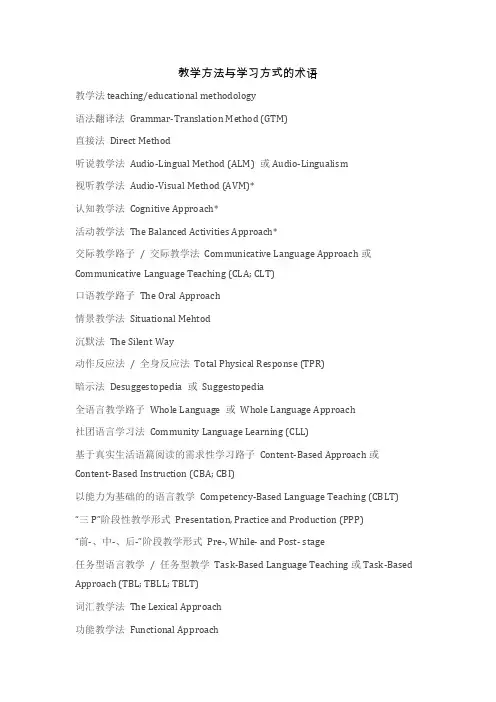
教学方法与学习方式的术语教学法 teaching/educational methodology语法翻译法Grammar-Translation Method (GTM)直接法Direct Method听说教学法Audio-Lingual Method (ALM) 或Audio-Lingualism视听教学法Audio-Visual Method (AVM)*认知教学法Cognitive Approach*活动教学法The Balanced Activities Approach*交际教学路子/ 交际教学法Communicative Language Approach或Communicative Language Teaching (CLA; CLT)口语教学路子The Oral Approach情景教学法Situational Mehtod沉默法The Silent Way动作反应法/ 全身反应法Total Physical Response (TPR)暗示法Desuggestopedia 或Suggestopedia全语言教学路子Whole Language 或Whole Language Approach社团语言学习法Community Language Learning (CLL)基于真实生活语篇阅读的需求性学习路子Content-Based Approach或Content-Based Instruction (CBA; CBI)以能力为基础的的语言教学Competency-Based Language Teaching (CBLT)“三P”阶段性教学形式Presentation, Practice and Production (PPP)“前-、中-、后-”阶段教学形式Pre-, While- and Post- stage任务型语言教学/ 任务型教学Task-Based Language Teaching或Task-Based Approach (TBL; TBLL; TBLT)词汇教学法The Lexical Approach功能教学法Functional Approach参与性学习Participatory Approach同伴辅助式语言学习法Peer-Assisted Language Learning (PALL)自然学习法The Natural Approach浸入式语言教学/ 渗透式语言教学路子Language immersion神经语言学程序化教学法Neurolinguistic Programming (NLP)学习策略训练Learning Strategy Training学生为核心的教学方式Learner-centered education自主学习方式autonomous learning学生自主化(学习自动化)students' autonomy 或learner autonomy 合作式语言学习(方式)Cooperative Language Learning合作化语言学习/ 协作性语言教学Collaberative Language Learning 发现式学习(探究性学习)Discovery Learning人文化教学/ 人文主义教学Humanistic approach个性化语言学习Personalized Language Learning学习个性化personalization多元智能(教学)Multiple Intelligences计算机辅助学习Computer-Assisted Language Learning (CALL)反思性教学Reflective teaching互交式教学Interactive teaching启发法/ 启发式教学Heuristic method 或heuristic teaching(原则化)折中教学路子Principled eclecticism*慕课MOOC微教学/ 微课教学/ 微课micro-teaching或mini-teaching微课程micro-teaching course微课micro-lesson(s) 或mini-lesson(s)翻转课堂Flipped lesson/classroom 或converted lesson/classroom 后教学法时代The post-method era课堂讲授式教学Whole-class teaching**个体化学习(方式)/ 个别化教学(方式)individualised learning。

英语教学法术语1.TEFL (Teaching English as a Foreign anguage)英语外语教学2.TESL (Teaching English as a Second Language) 英语二语教学3.CLT (Communicative Language Teaching) 交际语言教学4.ELT (English Language Teaching) 英语教学5.LAD (Language Acquisition Device) 语言获得机制6.TBL (Task-Based Learning) 任务型教学模式7.CLL (Community Language Learning) 团体教学模式8.EPT 英语标准化考试9.外语教学法的主要流派Grammar Translation 语法翻译法Direct Method 直接法Audio Lingual Approach 听说法Audio Visual Approach 视听法A Cognitive Approach to Language Learning 认知法Functional Approach 功能法The Communicative Approach 沟通教学法(交际教学法)Reading Approach 阅读教学法10.评价体系formative assessment 形成性评价summative assessment 终结性评价11.习语言知识的方法Inductive learning 归纳法deductive learning 演绎法12.综合语言应用能力的五个构成要素Language knowledge and communicative functions (语言知识与功能)Language skills 语言技巧Learning strategies 学习策略Cultural awareness 文化意识Positive attitude to learning 情感petence 能力the communicative competence 交际能力the language competence 语言能力the use of the language competence 语言运用能力nguage faculty 语言才能15.testing 英语测试diagnostic test 诊断性测试periodical achievement test 阶段测试proficiency test 水平测试16.ppp(3p)模式:呈现presentation 练习practice 运用production 17.语言科学普通语言学general linguistics神经语言学neurolinguistics社会心理学sociolinguistics心理语言学psycholinguistics应用语言学applied linguistics语用学pragmatics (pragmatic linguistics) 实用语言18.外语教学的研究方法observation method (观察法)survey method (调查法)experimental method 实验法analytical method 分析法data study 文献研究法19.动机instrumental motivation 工具性动机integrative motivation 融合性动机20.Theory of trial and error 尝试错误学说theory of classical conditioning 经典的条件反射学说Twinkle, twinkle, little starTwinkle, twinkle, little star, 一闪一闪小星星,How I wonder what you are. 我多想知道你是什么呀!Up above the world so high, 高高挂在天空上,Like a diamond in the sky, 好像钻石在天上,Twinkle, twinkle, little star, 一闪一闪小星星,How I wonder what you are. 我多想知道你是什么呀!Twinkle, twinkle, little star,How I wonder what you are.Up above the world so high,Like a diamond in the sky.Twinkle, twinkle, little star,How I wonder what you are!Twinkle, twinkle, little star,How I wonder what you are!Then the traveler in the darkThanks you for your tiny sparkHe could not see which way to go,If you did not twinkle so.Twinkle, twinkle, little star,How I wonder what you are!。
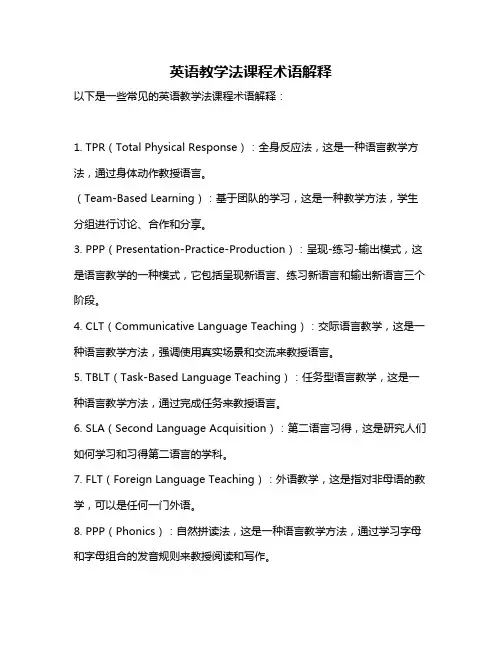
英语教学法课程术语解释以下是一些常见的英语教学法课程术语解释:1. TPR(Total Physical Response):全身反应法,这是一种语言教学方法,通过身体动作教授语言。
(Team-Based Learning):基于团队的学习,这是一种教学方法,学生分组进行讨论、合作和分享。
3. PPP(Presentation-Practice-Production):呈现-练习-输出模式,这是语言教学的一种模式,它包括呈现新语言、练习新语言和输出新语言三个阶段。
4. CLT(Communicative Language Teaching):交际语言教学,这是一种语言教学方法,强调使用真实场景和交流来教授语言。
5. TBLT(Task-Based Language Teaching):任务型语言教学,这是一种语言教学方法,通过完成任务来教授语言。
6. SLA(Second Language Acquisition):第二语言习得,这是研究人们如何学习和习得第二语言的学科。
7. FLT(Foreign Language Teaching):外语教学,这是指对非母语的教学,可以是任何一门外语。
8. PPP(Phonics):自然拼读法,这是一种语言教学方法,通过学习字母和字母组合的发音规则来教授阅读和写作。
9. ESL(English as a Second Language):英语作为第二语言,这是指非英语母语者学习英语的情况。
10. EFL(English as a Foreign Language):英语作为外语,这是指英语作为非母语被学习的情况。
以上是部分常见的英语教学法课程术语,每个术语都有其特定的含义和应用。
希望对您有所帮助。
专业英语必备词汇首次分享者:I am 22已被分享4次评论(0)复制链接分享转载删除人为环境 artificial environment三段教学法 three formal lesson-steps; three formal steps口述作文 oral composition口授 oral instruction; oral teaching; verbal instruction口算 oral arithmetic口语表达 oral expression口头报告法 oral report method小学学科 primary subject工作单元 unit of work; work unit中文点字法 Chinese Braille method五段教学法 five formal lesson-steps; five formal steps分析教学 analytic instruction分科教学 departmental teaching分级;分班 class grouping分组制 group system分组教学 group instruction分组实验法 brigade-laboratory method少年文学 juvenile literature幻灯片 lantern slide心算 mental arithmetic户外作业 out-door study; out-door work户外运动 out-door sport手工训练 manual training手工教室 manual-training room手语法 sign language手语术 chirology; dactylogy文化学科 culture subject文学科目 literary course方案课程 project curriculum日志法 diary method日课表 daily program; daily schedule; programme; time schedule 主科 major subject主学习 primary learning出席 attendance出席簿 attendance book可教性 educability必修学科 required subject本土知识 native knowledge正反例证法 method of positive and negative cases正式学科 formal subject正误例证法 method of right and wrong cases示范 demonstration示范法 demonstration method; method of demonstration示范教学 demonstration teaching再教育 re-education再发现法 method of rediscovery同心圆方法 concentric circle method同时教学法 simultaneous method同时学习 simultaneous learning同侪教练 peer-coaching年级分组制 grade group plan成绩进步表 grade-progress table自由游戏 free play自行活动教学法 method of self-activity自我向导 self-direction自修 self-culture自习 self-study自然科学通论 General science自然发音法 phonetic method作业指定 assignment; lesson assignment作业单 assignment sheet儿童中心教育 child-centered education儿童画 children's drawing玩具 plaything; toy盲人用凸体文字 raised type for the blind直接训练 direct discipline直接教学法 direct method of teaching直观法 intuitive method直观教学 intuitional instruction知识科目;资讯学科 information subject社会化教学 Socialized teaching初级读本 primer附学习 accretion learning; concomitant learning持续的课程 constant in curricula; curricula-constant指定科目 prescribed course指定读物 required reading指算 Finger manipulation指语 Finger speech; Finger language指语字母 Finger alphabet指导的游戏 directed play指导的学习 directed learning; directed study指导练习 coaching指读法 Finger reading是非法 right-wrong method; true-false method; yes-no method 活动;作业 activity活动分析 activity analysis活动电影 kinematography活动课程 activity curriculum活动学校 activity school相互教学制 mutual system研究学程;研究科目;专题研究科目 seminar course科目 course科目;学科 subject背诵法 method of recitation胎教 antenatal training乘法表 multiplication table个别教育 individual education个别教学 individual instruction; individual teaching个别阅读 individual reading个案研究[法] case study method家庭作业 home work家庭课业 home lesson恩物 Gift时事教学 current events instruction朗诵 oral reading案例分组法 case-group method案例法 case history method; case method; case study method 案例教学法 case method of instruction特殊教育 special education特殊教学法 special didactics班级教学 class teaching班级经营 class management; classroom management记诵 memorization记忆训练 memory training记忆术 memory system; mnemonic system; mnemonics讨论法 method of discussion训育学 didactics做中学 learning by doing副学习 associate learning参考书 reference book问题法 problem method国定教科书 national textbook基本科目;基本学科 fundamental subject基本英语 basic English基本学习 basic studies基础课程{英语反复练习} basal course基础读物 foundation reader专业训练 professional training专业课程 professional curriculum强记 hypermnesia从生活中学习 learning through living从经验中学习 learning by experience推广科目 extension course教材 material of instruction; matter for teaching; subject matter; subject-matter教材选择 selection of subject matter教育电影 educational cinema教室讨论 class discussion教室参观 class visitation教室课表 room schedule教科书 school book; text-book; textbook教案 lesson plan教学日志 diary for instruction教学法 method of instruction; method of teaching; teaching method 教学科目 course of instruction教学效能 teaching efficiency教学专业 profession of teaching教学单元 method-whole of teaching; teaching unit教学模式 model of teaching启发式教学 developmental mode of teaching; heuristic mode of teachi ng略读 rough reading; skimming reading设计问题法 project problem method设计教学法 project method of teaching; project teaching method部分学习法 part learning method; part method野外实习 field practice博览法 extensive method普通教授学 General didactics普通教学法 general method of teaching智能障碍教育 education for mental retardation发表教学 presentative instruction发表学科 expressive subject童话 nursery tale进步测验 progress test间接训练 indirect discipline间接教学法 indirect method of teaching间接学习 indirect learning集中学习 massed learning填充法 completion method新生训练 orientation course会话法 conversational method经验法;实征 empirical method补充阅读 collateral reading补充读物 supplementary book; supplementary reading试探科目 exploration course [= exploratory course]诘问考试 cross-examination跳读 skipping reading游戏法 play method游戏理论 play-theory顿悟学习;洞悟学习 insight learning尝试错误法 method of trial and error; trial and error method 团体游戏 organized play图示 graphical representation图示教学法 pictorial method; picture method图画完成测验 picture completion test实地工作 field work实地学习课 field lesson实作测验 practice test实物 material object实物教学 object lesson; object teaching实习;练习 practice实习课;练习课 practice lesson实验教育 experimental education实验教育学;实验教学论 Experimental pedagogy实验教学法 experimental didactics实验学校 experimental school; laboratory school演示课 demonstration lesson演讲;辩论术 elocution [= oration]精读 detailed reading综合教学 synthetic instruction语言矫正班 speech-correction class说话教学 speaking-instruction辅助班级 auxiliary class辅助学校 auxiliary school辅导算术 remedial arithmetic辅导学习法 supervised study札记法 notebook method弹性分组制 flexible shifting group plan弹性升级 flexible promotion模仿学习 learning by imitation练习法 drill method; practice method练习极限 practice limit课 lesson课程 curriculum课程分化 curricula-differentiation; differentiated curriculum 课程表 program of studies; table of curriculum课程建构 construction of curriculum课间自习 busy work适性教育 adaptive physical education阅读法 reading method阅读书单 reading list学年会议 grade forum学校科目 school subject学习指导 direction of learning学习效率 learning efficiency整句教学法 sentence method整体学习法 whole learning method机械记忆 rote memory机械教学 rote teaching机械学习 rote learning机机学习 learning by chance独立阅读 independent reading选习科 elective subject; optional subject选择题 multiple-choice test随机教育 incidental education随机教学法 accidental teaching method; incidental teaching method 随机学习 incidental learning默写 dictation默读 silent reading婴儿班 baby class戏剧表演法 method of dramatic expression营养学 dietetics矫正教育{智能障碍教育} Correctional education; Corrective educati on联想学习 associative learning螺旋法 spiral method讲述法 method of telling讲授;教导;教学 instruction讲演 lecture讲演示范法 lecture-demonstration method讲演法 lecture method; method of lecture点字法 Braille method简字 simplified spelling简明教科书 brief textbook证明法 method of verification难题箱 problem box露天教学班 fresh-air class读书会 reading circle读写算 three R's体育指导员 athletic director观念联合;联想 association of ideas观察法 observation method。
以下是英语中八种常见的教学法的英文表达:
Lecture Method(讲授法):通过教师的口头讲解传授知识和概念。
Demonstration Method(示范法):通过展示和示范教学内容,帮助学生理解和掌握技能。
Discussion Method(讨论法):通过学生之间的互动和讨论,促进学生的思考和理解。
Inquiry Method(探究法):通过引导学生自主提问、探索和发现知识,培养学生的独立思考能力。
Cooperative Learning(合作学习):通过小组合作学习,培养学生的合作能力和团队精神。
Problem-Based Learning(问题导向学习):通过解决实际问题或情境,培养学生的问题解决能力和批判性思维。
Project-Based Learning(项目导向学习):通过完成项目任务,培养学生的综合能力和实践技能。
Task-Based Learning(任务导向学习):通过完成具体任务,培养学生的语言运用能力和实际应用能力。
请注意,这些教学法的名称可能有不同的表达方式,具体术语可能会因不同的教育体系和学术领域而有所差异。
整个教学法名词解释教学法是指教师在教学过程中所采用的一系列方法和技巧。
不同的教学法适用于不同教学目标、教学内容和教学对象。
以下是一些常见的教学法和相关术语的解释。
1. 传统教学法:传统教学法是一种以教师为中心的教学方法,教师在课堂上传授知识,学生则被动地接受。
这种教学法重视教师的权威和讲解力度,强调知识的传授和记忆。
传统教学法适用于一些基础知识的灌输和技能的培养。
2. 问题导向教学法:问题导向教学法是一种以问题为导向的教学方法,教师通过提出问题引导学生思考和探索。
这种教学法注重培养学生的解决问题的能力和批判性思维,并激发学生的学习动力和兴趣。
3. 合作学习法:合作学习法是一种以合作为基础的教学法,学生之间相互合作,共同完成任务。
通过合作学习,学生可以相互交流和分享知识,培养团队合作和沟通能力。
4. 课堂讨论法:课堂讨论法是一种以讨论为核心的教学方法,学生在教师的引导下参与讨论和交流。
通过课堂讨论,学生可以表达自己的观点,增强思辨和表达能力。
5. 情景教学法:情景教学法是一种通过情境和场景设置来进行教学的方法。
教师将学生置于真实的环境中,让学生亲身体验和参与,以促进学生的学习和理解。
6. 体验教学法:体验教学法是一种通过亲身体验来进行教学的方法。
学生通过实地考察、实验、模拟等活动来获取知识和经验,在实践中学习和探索。
7. 个别化教学法:个别化教学法是一种根据学生的个体差异,对学生进行个别教学和指导的方法。
教师根据学生的不同能力和学习风格,设计个性化的学习任务和教学策略。
8. 潜入式教学法:潜入式教学法是一种在学生的实际生活和社交环境中进行教学的方法。
教师通过与学生的互动和观察,发现学生的学习需求,并以生活化的方式进行教学。
9. 反转课堂教学法:反转课堂教学法是一种将课堂时间用于学生互动和实践,而将教师的讲授内容放到课堂外完成的方法。
学生通过在课堂外预习教材,课堂上由教师引导进行讨论和学习。
10. 个案教学法:个案教学法是一种以个别学生的案例为基础,进行针对性教学的方法。
英语教学方法名称
以下是一些常见的英语教学方法名称:
1. 情景教学法(Situational Teaching Method)
2. 音乐教学法(Music Teaching Method)
3. 交际教学法(Communicative Language Teaching)
4. 语言经验教学法(Language Experience Approach)
5. 任务教学法(Task-based Learning)
6. 联想教学法(Association Teaching Method)
7. 团体教学法(Group Teaching Method)
8. 游戏教学法(Play Method)
9. 直接法(Direct Method)
10. 快乐教学法(Happy Teaching)
11. 翻译法(Translating Method)
12. 讲授法(Expository Method)
13. 语法翻译法(Grammar-Translation Method)
14. 听说教学法(Audio-Lingual Method)
这些教学方法在英语教学中起着重要的作用,每种方法都有其独特的特点和适用范围。
在实际教学中,教师可以根据学生的需求和实际情况选择合适的教学方法。
有效教学策略教育学术语
有效教学策略教育学术语
1. 层次教学法(Hierarchical Teaching):是指把一个整体的任务或技能分解成一系列的相关步骤,从而循序渐进地掌握。
2. 模块设计法(Modular Design):是指将一系列知识或技能的学习分割成离散的模块,以便更快速地完成学习任务。
3. 情境教学法(Contextual Teaching):是指把学习的知识与应用环境紧密结合起来,通过实际活动来促进学习者更好地理解和掌握知识。
4. 视觉化教学法(Visualization Teaching):是指利用媒体资源,通过画面、动画等形式来帮助学习者将抽象的概念自然化,从而达到更快更好地理解学习内容的目的。
5. 合作学习法(Cooperative Learning):是指利用小组形式,以及相互之间的协作与交流,让学习者共同学习和探究新的知识,帮助学习者更好地理解学习内容。
6. 认知发展教学法(Cognitive Developmental Teaching):是指根据学生的发展水平,灵活设计学习内容,让学习者通过不断的思考、发现和实践,最终发展出知识体系,从而更加深入、系统地理解学习内容。
7. 反馈教学法(Feedback Teaching):是指给予学习者有效的反馈及其他帮助,让学习者能够根据不断调整自己的学习方式,从而达到更好地理解学习内容。
教学法名词解释1.Testing: Testing often takes the ‘pencil and paper’ form and it is usually done at the end of a learning period. The result is often expressed by a mark, a grade or a ratio.2. Evaluation:Evaluation can be concerned with ‘a wide range of issues in and beyond language education: lessons, courses, programs, and skills can all be evaluated.’ It involves making an overall judgment about one’s work or a whole school’s work.3.Bottom-up model: It follows a linear process from the recognition of letters to words, to phrases, to sentences, to paragraphs, and then to the meaning of the whole text.4.Interactive model: During the reading process, our mind by interacting with the printed page---its words, phrases, sentences, as well as the context it provides can be stimulated and a proper schema will be activated to allow us to relate the incoming information to already known information.5.Denotative meaning: Denotative meaning of a word or a lexical item refers to those words that we use to label things as regards real objects, such as a name or a sign, etc. in the physical world. This is usually the primary meaning of a word and may seem relatively easy to learn.6. Collocations: Collocations refers to words that co-occur with high frequency and have been accepted as ways for the use of words. It is believed that teaching word collocations is a more effective way than just teaching one single word at a time.7.Assessment:Assessment involves the collecting of information or evidence of a learner’s learning progress and achievement over a period of time for the purposes of improvingteaching and learning. It is not based on one test or one task, nor is it expressed by a mark or grade, but rather ina report form with scales or levels as well as description and comment from the teacher.8. Education: Education comes from the Latin verb educare, which means to ‘bring out’. In other words, teachers should try to bring out the full potential of their students as human beings, so they can live meaningful, fulfilling and responsible lives.9. Top-down model: in teaching reading, the teacher should teach the background knowledge first so that students equipped with such knowledge will be able to guess meaning from the printed page. This process of reading is said to follow the top-down model.10.Total Physical Response:this method of teaching concentrates on learning language by listening and responding physically to commands or directions.11. Connotative meaning: A connotative meaning of a word refers to ‘the attitudes or emotions of a language user in choosing a word and the inference of these on the listener or reader’s interpretation of the word.12. Constructivist theory: constructivist theory believes that learning is a process in which the learner constructs meaning based on his/her own experiences and what he/she already knows. John Dewey provided a foundation for constructivism. He believed that teaching should be built based on what learners already knew and engage learners in learning activities.13. Receptive vocabulary: Receptive vocabulary refer to words that one is able to recognize and comprehend in reading or listening but unable to use automatically in speaking orwriting.14. The deductive method: The deductive method relies on reasoning, analyzing and comparing.First the teacher writes an example on the board or draws attention to an example in the textbook. Then the teacher explains the underlying rules. Sometimes comparisons are made. Finally the students practice applying the rule to produce sentences with given prompts.15. Critical Period Hypothesis: This hypothesis states that if humans do not learn a foreign language before a certain age (perhaps around puberty), then due to changes such as maturation of the brain, it becomes impossible to learn the foreign language like a native speaker.16. Open questions: Open questions may invite many different answers.17. Cognitive theory: According to Chomsky, language is nota form of behaviour, it is an intricate rule-based system and a large part of language acquisition is the learning of this system.18.Higher-order questions:Higher-order questions require more reasoning, analysis, and evaluation.19. Mistakes: A mistake refers to a performance error that is either a random guess or a ‘slip of tongue’, and it is a failure performance to a known system.20. A task: A task is a piece of work undertaken for oneself or for others, freely or for some reward.21. Behaviorist theory: Behaviorist theory of language was initiated by behavioral psychologist Skinner, who applied Watson and Raynor’s theory of conditioning to the way humans acquire language. In this theory all complex forms of behavior are seen as composed of simple muscular and glandular elements that canbe observed and measured. Skinner suggested that language is alsoa form of behaviour. It can be learned the same way as an animal is trained to respond to stimuli.22. Hyponyms: Hyponyms refer to words which can be grouped together under the same superordinate concept.23. Productive vocabulary: Those words that one is not only able to recognize but also able to use in speech and writing are considered as one’s productive/active vocabulary.24. The inductive method: In the inductive method, the teacher provides learners with authentic language data and induces the learners to realize grammar rules without any form of explicit explanation.25. Closed questions: Closed questions refer to those with only one single correct answer.26. Display questions: Display questions are those that the answer are already known to the teacher and they are used for checking if students know the answer, too.27. Lower-order questions: Lower-order questions refer to those that simply require recalling of information or memorization of facts.28. Errors: An error has direct relation with the learners’ language competence. Errors do not result from carelessness nor hesitation, but lack of knowledge in the target language. Language errors cannot be self-corrected no matter how much attention is given.29. A lesson plan: A lesson plan is a framework of a lesson in which teachers make advance decisions about what they hope to achieve and how they would like to achieve it.30. Task-based Language Teaching: Task-based LanguageTeaching is a further development of Communicative Language Teaching. It has stressed the importance to combine form-focused teaching with communication-focused teaching.。
教学法术语(一)Teaching Plan Terms (教案术语) Subject 科目Teaching materials教材Title of the text课文题目Topic n. 课题、题目A teaching plan教案Aims (the aims of teaching)教学目的Purpose教学目的Aims an demands 目的和要求Teaching approaches教学途径Main points (the key points of teaching)重点Difficult points 难点The main points of teaching 教学重点Teaching focuses教学重点Allocation of time时间分配Teaching time课时Step (the step of teaching )教学步骤Organization of the lesson组织教学The arrangement of teaching 教学安排Consolidation(the consolidation of teaching )巩固教学Teaching methods 教学方法Indirect method间接法Direct method 直接法1Experimenting method实验法Discovery method演绎法Talking method谈话法Review method 复习法Showing method 演示法Observing method观察法Explain 讲解Give a lecture讲演Describe ,recount ,relate 讲述Practice of spoon-feeding注入法The method of elicitation 启发式English teaching outline英语教学提纲The first lecture第一讲The first period第一节Teaching hour (teaching time )讲课时数Checking the homework 检查家庭作业Object lesson/ teaching实物教学Setting the homeworkAssigning the homework 布置家庭作业Setting the assignmentTeaching the new words 词汇教学Analysis of text课文分析Teaching grammar语法教学On-the-spot teaching 现场教学Team teaching协作教学Demonstration teaching演示教学Teaching with electric audio-visual aids电化教学2Teaching by demonstration示范教学The law of teaching 教学规律The rules of teaching (teaching principles)教学规则The end of education /the aims of education 教学目的Learn (master) ten mew words and be able to use them in actual situations 掌握并能实际应用十个生词。
Develop the students’ skill(cultivate proper habits) in reading and writing 提高和发展学生的读与写的能力。
Develop the students’ ability to listen and speak提高学生的听说能力Grasp the main ideas of the text ,and be able to answer questions on it 掌握课文要点并能回答问题Audio –visual aids视听教具Teaching aids (tools)教具Mastery of SQ3R掌握SQ3RDictation materials听写材料Dictation materials in teacher’s junior book 4 on page 102听写材料见初中四册英语教参102页Summing up / summary/summarizing 总结(二)1.Classroom English 课堂用语A . Before Class Begins 上课前1. Will the bell ring soon?铃快响了吗?2. How many minutes are there to go ?还有多少分钟?3. There are five minutes to go. 还有五分钟。
4. There goes the bell. 铃响了.5. Is it time for class? 是上课时间吗?6. Be ready for class.准备上课。
7. Are you ready ?你们准备好了吗?38. Get your things ready, please.请把东西准备好。
9. Please take out your books (note-books, pencil-boxes) and put them on your desks. 请把书(笔记本、铅笔盒)拿出来,放到桌子上。
10.The second (first) bell is ringing .上课(预备)铃响了。
11.The teaching is coming. 老师来了。
12. Here comes the teacher .老师来了。
13.Be quiet (silence), please.请安静。
14.Don’t talk any more .不要再谈话了。
15.No (stop) talking, please.不要讲话(停止讲话)。
16.You are too noisy. 你们太吵了。
17.Don’t be so noisy.不要这样吵了18.Don’t whisper to one another.不要交头接耳。
19.No whispering allowed. 不许小声说话。
20.Stop chattering. 不要瞎聊。
21.That’s impolite. 那样不礼貌。
22.Sit up (straight properly). 坐直(坐正)。
23.Don’t fidget. 别搞小动作。
24.Don’t fool with your pencil. 别拨弄你的铅笔。
25.Get everything ready for class.做好上课的一切准备。
B. Beginning a Class 开始上课26.Class begins! 上课!27.Let’s begin.上课!28.Stand up! 起立!29.Good morning ,students (boys and girls ,comrades ,children ,teacher)!同学们(老师),早上好!430.Good afternoon (evening), class (teacher)! 同学们(老师)下午(晚上)好!31. How are you , comrades? 同学们好吗?32. We are fine, thank you, and you? 我们都很好,谢谢,你呢?33.I’m fine, too. thank you .谢谢,我也很好。
34. Please sit down .请坐下。
35. Please be seated. 请坐下。
36.Who’s on duty today? 今天是谁值日?37.Is everyone here (present)? 都到齐了吗?38.Is anyone absent? 有谁缺席?39.Who’s absent? 是谁缺席?40.What’s the matter with him (her)? 他(她)怎么啦?41.Did he (she) ask for leave? 他(她)请假了吗?42.Have you anything to report to the class? 你有什么要向班上报告呢?43.Let’s have a roll call (call the roll). 我点一下名。
44.Answer when your name is called. 叫到你的名字请答“到”。
45.Wu Dong. 吴东?46.Here(present). 到!47.Sorry, I’m late. 请原谅,我迟到了。
48.Don’t be la te next time.下次别迟到了。
49.Your classroom looks nice and clean. 你们的教室美观,干净。
50.You have done your duty well. 你们的值日做得很好。
51.Your classroom doesn’t look so tidy today.你们的教室今天不够整洁。
52.You haven’t done your duty well enough. 你们的值日做得不够好。
53.Well, don’t forget to perform your d uty next time.下次别忘了做值日。
54.Have you seen the chalk and blackboard eraser? 你们知道粉笔和黑板擦放在哪里吗?55.All the chalk has been used up. Please get some more from the office. 粉笔都用光了,请到办公室再拿些来。
5C.Class Plan Introduction 课堂计划导言56.We’ll start (take up) a new lesson today. 我们今天开始上新课57.We are going to have a new lesson today. 我们今天上新课。
58.We’re going to review some of the old lessons today.我们今天复习一些旧课。
59.We’ll do three things this period , first, we’ll review the old lesson, second, we’ll learn a new lesson ,Lesson 10,third ,we’ll h ave somelistening practice (oral drills, written exercises ,a test ,a quiz).这节课我们要做三件事:1)复习旧课;2)学习新课,第10课;3)听写练习(口头练习,笔头练习,考试,测验)60.Today, the class will be conducted in this way…今天的课这样进行……61.Today we shall have a review of what we have learnt this week.今天我们把这周所学的东西复习一下。